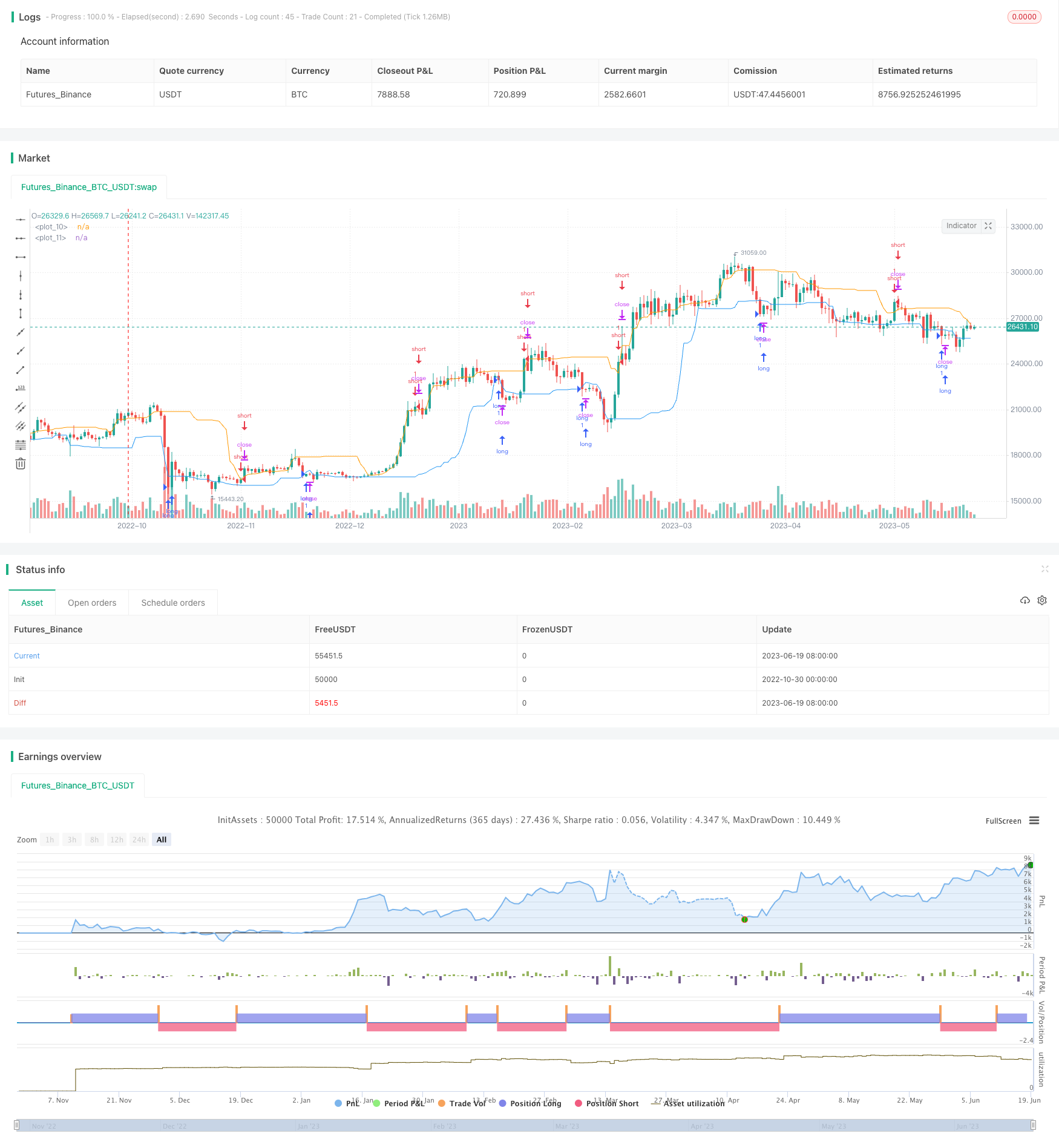
概述
该策略结合Chande Kroll止损指标和平均趋向指数(ADX)指标,实现了一个相对简单的趋势跟踪策略。Chande Kroll止损用于生成长短仓入场信号,ADX用于过滤掉无明显趋势的市场情况,避免无方向的震荡市导致止损反复触发。
策略原理
该策略首先计算Chande Kroll止损的长线stop_long和短线stop_short。长线由过去p周期内的最高价计算,短线由过去p周期内的最低价计算。然后用过去q周期内长短线的最高点和最低点作为当前的长短止损线。这样可以滤除短期价格震荡的影响,只在趋势转折点触发止损。
当收盘价上穿短线stop_short时,产生做多信号;当收盘价下穿长线stop_long时,产生做空信号。
此外,策略加入ADX指标判断趋势强弱。只有在ADX大于阈值时,止损信号才会触发入场。这可以过滤掉盘整震荡时止损的误报。
策略优势
该策略结合趋势指标和止损指标的优点,既可以及时捕捉趋势转折,又可以避免无方向市场的 whip saw。Chande Kroll止损的参数优化可以平滑滤波,确保只在趋势转折时止损。ADX指标确保只在趋势明显时入场,可以避免震荡市的止损跳空。
策略风险
ADX参数设置不当可能错过趋势开始的机会。如果ADX阈值设置过高,在趋势开始阶段就可能因ADX值过低而错过入场机会。
止损点过近也可能造成策略仓位频繁打开和关闭。这会增加交易成本和滑点成本。止损点需要合理设置,给予趋势一定的视角。
策略优化
可以考虑在ADX升破某个阈值时才允许止损信号触发,这样可以提高入场时机的可靠性。还可以结合其他趋势指标进行组合判断,如将ADX值与EMA斜率进行组合等。
止损线也可以考虑根据ATR动态调整,在市场波动加大时扩大止损空间,避免过于灵敏。或者可以结合MACD等辅助指标评估趋势强弱,动态调整止损线。
总结
该策略整合Chande Kroll止损和ADX指标的优势,实现了一个相对简单实用的趋势跟踪策略。通过参数优化,可以进一步提高策略的稳定性和盈利能力。但需要注意防止止损过于灵敏和ADX过滤过于宽松造成的风险。
/*backtest
start: 2022-10-30 00:00:00
end: 2023-06-20 00:00:00
period: 1d
basePeriod: 1h
exchanges: [{"eid":"Futures_Binance","currency":"BTC_USDT"}]
*/
//@version=5
strategy(title = "Chande Kroll Stop", overlay=true)
p = input.int(10, minval=1)
x = input.int(1, minval=1)
q = input.int(9, minval=1)
first_high_stop = ta.highest(high, p) - x * ta.atr(p)
first_low_stop = ta.lowest(low, p) + x * ta.atr(p)
stop_short = ta.highest(first_high_stop, q)
stop_long = ta.lowest(first_low_stop, q)
plot(stop_long, color=color.blue)
plot(stop_short, color=color.orange)
adxlen = input(14, title="ADX Smoothing")
dilen = input(14, title="DI Length")
ADX_sig = input.int(20, title="minimum ADX threshold for signal")
dirmov(len) =>
up = ta.change(high)
down = -ta.change(low)
plusDM = na(up) ? na : (up > down and up > 0 ? up : 0)
minusDM = na(down) ? na : (down > up and down > 0 ? down : 0)
truerange = ta.rma(ta.tr, len)
plus = fixnan(100 * ta.rma(plusDM, len) / truerange)
minus = fixnan(100 * ta.rma(minusDM, len) / truerange)
[plus, minus]
adx(dilen, adxlen) =>
[plus, minus] = dirmov(dilen)
sum = plus + minus
adx = 100 * ta.rma(math.abs(plus - minus) / (sum == 0 ? 1 : sum), adxlen)
sig = adx(dilen, adxlen)
if ta.crossunder(close, stop_long) and sig>ADX_sig
strategy.entry("long", strategy.long)
if ta.crossover(close, stop_short) and sig>ADX_sig
strategy.entry("short", strategy.short)